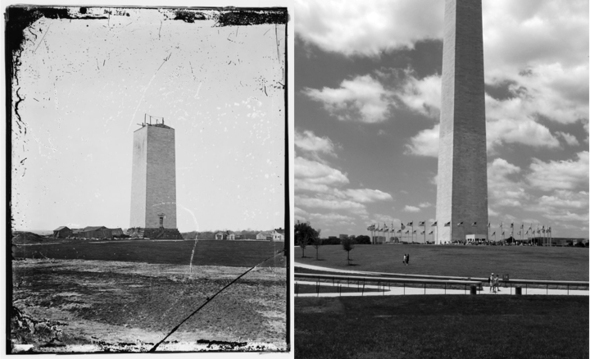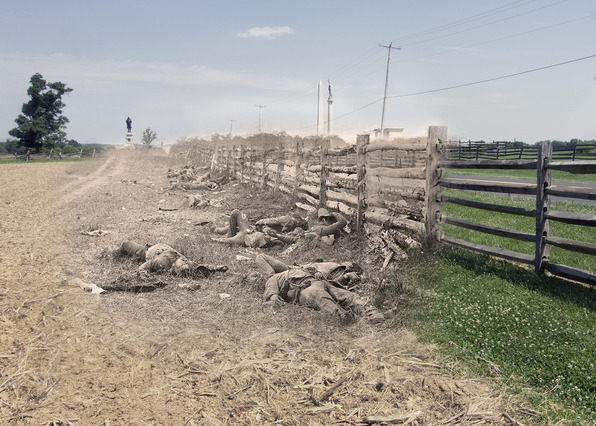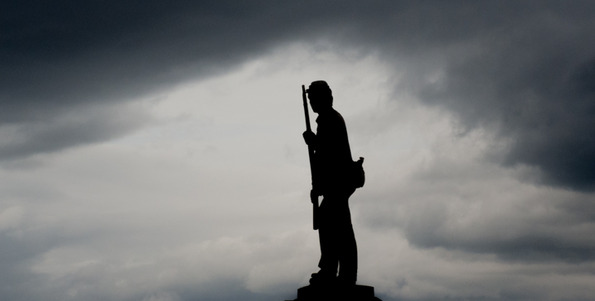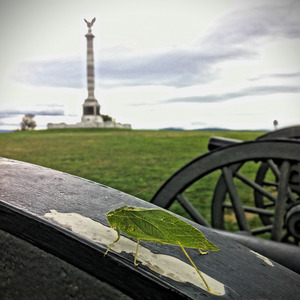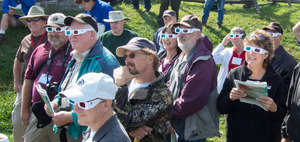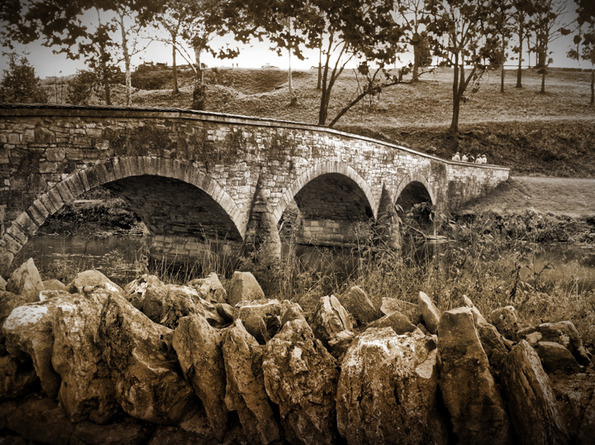One pleasant summer evening last year in August, I had finished my work for the day and was relaxing in my back yard in Bay Village Ohio, two blocks from Lake Erie, having a beer and watching the sun go down.
I happened to have my laptop with me, and I did something I had not done for a month or two – look at my saved searches on eBay. I have been active on eBay since the mid 90’s, mostly as a seller. One of my saved searches was “64th N.Y.”I’ve been fascinated by the Civil War at least since 1961, when I was nine years old, and since childhood I’ve known that my great-grandfather, Calvin Benjamin Pratt, had served in the Union Army during the Civil War along with his older brother Thomas, my great uncle. I knew that Thomas Pratt had been mortally wounded in the bloody, tragic assault on Marye’s Heights during the Battle of Fredericksburg. Both men had served in the 64th New York Infantry Regiment. So for the past 20 years or so, from time to time I’d search eBay for ”64th N.Y.” This always yields a lot of 64th scale model cars. So I narrowed in down to photographs and began scrolling.
Up popped: “ID’D 1860s CIVIL WAR 6th PLATE TINTYPE “DOW” THOMAS PRATT NEW YORK 64th INFANTRY.” (Editor’s note: DOW stands for Died Of Wounds)
I read it again slowly. I wanted to be sure it really said what it did. I thought to myself, “This just can’t be! What are the odds?”
Several good, clear photos of the image were displayed. One showed the back of the plate, and I could see words scratched onto the surface. They read “Bn Pratt, Co F 64th NY, Little Valley.”
Seeing the name “Pratt” scratched on the back of the tintype itself erased all doubts. “My God, this really is my great uncle!” I said to myself. Four days were left in the auction. Eight bids had taken the price to just over $100.00. I hurriedly called CCWP President Bob Zeller. We’ve been friends since the 1970s.
“You’ve got to own this,” he said. “Finding an IDed Civil War photograph of your relative is almost unheard of! Eight out of 10 solder images you see at a Civil War show are unidentified. Having any ID with a Civil War tintype is uncommon. Don’t screw around. Bid high enough to ensure you get it.”
His prediction was that it would sell in the $500 – $700 range, so I was thinking to bid $800. I’ve never paid anywhere near that much for a photograph.
I don't remember when my obsession with the Civil War started, but it probably pre-dates my obsession with photography by a few years. I graduated from the University of Missouri School of Journalism in 1974, as did Bob, and become a photojournalist. I’ve been a photographer or photo editor my entire career.
I know my interest stretches back to 1961, when my family went on a summer vacation that included stops at Gettysburg and Manassas. Being only nine years old, all I remember from the trip to Gettysburg was the Electric Map and staying at a boarding house.
But I remember Manassas. We parked at the Visitor's Center and my sister and I went running up a little rise. We stopped short at the top, because ahead at the bottom of the slope was a long line of Confederates, in butternut, advancing up the hill towards us. "Center on the girl in the blue dress," my Dad heard an officer say. Turns out it was the Virginia National Guard practicing for the Centennial reenactment.
I was hooked, and from then on we didn't play WWII soldiers in the neighborhood, it was Civil War. We had a Union and Confederate unit, officers, spies, and on weekends would fight in the nearby fields and hills around Salamanca, the small town in Western New York where I lived.
I was a Confederate soldier at Halloween (photo). I built models of the Monitor and Merrimac, devoured the National Geographic Civil War issues celebrating the Centennial and had one of their maps on my bedroom wall. At some point, my mother told me about my great-grandfather and his older brother and how they had fought in the 64th N.Y. during the war, and that my great uncle had been killed. But along came college and girls and my interest waned.
My first full-time job was as a photojournalist for the Jackson (MS) Clarion-Ledger. There I met Bob, a reporter who was one of many young journalists who had been hired to report for Mississippi’s largest newspaper. We discovered our mutual passion for Civil War history and auto racing and became fast friends and when we discovered our mutual passion for the Civil War that cemented it. We visited Vicksburg together, where the U.S.S. Cairo had just gone on display, and I spent lots of time at Champion Hill and Port Gibson as well.
Bob and I even found time to develop an Antietam board game. He drew the hexagons on a large map. I researched and constructed the unit markers and together we drew up the rules. Both of us thought the square markers on commercial Civil War board games were just not the correct shape, and we made ours rectangular, more like the way regiments are shown on a battle map.
In 1980 I moved to Michigan for another job and we continued to play by mail, like chess. Bob was the Best Man at my wedding in Flint, MI, in 1983 and I remember he waved a small Confederate flag (which I still have) as part of his speech.
As luck would have it. Bob was now working at the Long Beach, Ca., Press-Telegram and as luck would have it, I took a job at the Orange County Register and moved into a house just 10 miles from his. We both became passionate about golf and spent many of those perfect southern California days on the links.
Bob’s parents had a little vacation place overlooking the Antietam battlefield and he had become fascinated by the journalism that came out of that battle and had started collecting original Sept. 1862 newspapers as well as Alexander Gardner’s stereographs and photos of the battlefield.
As he embarked on a path that years later would lead to the creation of The Center for Civil War Photography, I reopened a dialogue with my mother about our family history.
She remembered seeing letters from her grandfather and uncle during the war. She canvassed all the relatives but could not turn them up. But in the Little Valley (Cattaraugus County, NY) Historical Society files, she found a photocopy of a letter from my great uncle, Thomas Pratt, that mentioned his brother. She also found a note of compiled information about him which indicated there was a “healthy correspondence” they kept up. But when she contacted the man who had compiled the information, he had no idea where that correspondence might be.
Nobody knew much about Thomas, except that he was mortally wounded at Fredericksburg and died on January 4, 1863 at Campbell Hospital outside Washington. He is buried at the National Soldiers Home cemetery in Washington, D.C., which pre-dates both Arlington and Gettysburg.
My grandfather, Calvin Benjamin Pratt, enlisted as soon as he turned 18, shortly before the Battle of Antietam. He missed that battle, but joined his brother in Company F a few weeks before the battle of Fredericksburg. It was sobering to realize they were back together only a short time.
I know nothing about my great-grandfather’s story at Fredericksburg, but it must have been awful. I often wonder about that. In any case, he went on to serve through the rest of the war. He was wounded on picket duty along the Po River the day before the battle of Spotsylvania, receiving a gunshot wound to his hand. He returned to his unit while they were at Petersburg and was mustered out in June 1865 as a private.
Back home from the war, Calvin married late, at about age 45 in 1890, and had several children, one of whom was Phebe Pratt, my maternal grandmother. He died when he was 60 after a long illness in which he had to move in with relatives for care, as his wife was unable to do so.. My mother took me to see his grave in Mosher Hollow cemetery, just north of Little Valley, during a visit to my folks in 2008.
After spotting the Pratt tintype and placing my bid, I had to wait out the several days remaining in the auction. I became increasingly nervous as each day passed. On the final day, I checked the status of the auction time and time again. With eight hours to go, it had jumped from $100 to $200.
As the end approached, I was focused in. I went over all of the information on the webpage once again. And when I scrolled to the bottom, I discovered that the seller had added a note I had somehow missed. On eBay, sellers can’t revise their original descriptions or title once a bid is placed. But they can add new information and answer buyer questions at the bottom of the page.
Someone who lived near Little Valley and was interested in the image had contacted the seller and told him he thought that the image was of Calvin Benjamin Pratt, not Thomas. He based this on the “Bn. Pratt” name that was scratched on the back of the plate.
I was dumbfounded. This was my great grandfather! I grabbed the family history folder my mom had put together and saved to look once again at the photo copy of that single letter we had from my doomed great-uncle Thomas Pratt, written in mid-November, 1862.
In it, I saw something that made my heart jump. Twice, Thomas referred to his brother “Ben.” Not Calvin. He went by “Ben.” Now I know the photo had to be of my great-grandfather.
A feeling of panic swept over me. Now I HAD to have this image. I called Bob again to tell him the new development but had to leave a voice message. About an hour was left in the auction. Should I change my bid? When Bob had told me not to mess around, he had suggested bidding $2,500.00. “That will get it for sure,” he said. I thought he was insane. It was just the thought of, “What if it does go that high?”
Bob wanted me to have it almost as much as I wanted it. “Something like this almost never happens,” he said. “It has to come home,” He suggested selling other items from my collection to cover it. He even offered to float me a loan if the price soared – very generous, but unnecessary. My hesitation came simply from the thought, “But what if it does go that high?”
With about 30 minutes to go, the tension was growing. I poured a nice IPA and sat down at the computer. I had decided to place a bid at the 30-second mark and make it high, knowing I probably wouldn’t have time to enter another.
Anyone who had bid on eBay for something special knows how nerve-wracking it is to wait out the end of an auction. But the tension goes sky high in the final seconds. Many eBay items are won by pre-set “snipe” bids that are automatically placed with only a second or two to go. I’ve done it myself. It’s part of the game.
I placed my final bid increasing my maximum amount, with 30 seconds to go. It wasn’t $2,500.00, but it wasn’t too far south of it either. At almost the same moment, the price began going up. It jumped by about $50 six more times. Finally, the clock ran out. It was mine. The price was right at the low end of Bob’s prediction.
A few days later, the package arrived. I carefully unwrapped it. There he was, my own great-grandfather, in full uniform, wearing pants that were several sizes too long for him, holding a rifle in front of a cheesy painted period backdrop.
It was in better condition that I had hoped, very clear and like most tintypes, a little on the dark side. My first order of business was to scan it at very high resolution. Then I carefully wrapped it back up.
I’d like to figure out a way to display it, possibly under glass in a shadow box. Or I may just make a nice print from the scan and keep the original safe and out of the light. And I am delighted to unveil the image in Battlefield Photographer. Because what good is a photo if you don’t share it?
My interest in the Civil War and my family’s role in it had fascinated me for almost half a century, yet in all that time, my mother and I had been able to uncover little more than the basic details of their service and that single letter written by Thomas.
Like a bolt out of the blue, the most tangible connection to my great-grandfather’s service in the Civil War – his original wartime portrait photograph in full uniform – had landed in my lap.
Now if I could only find those letters.
Reprinted with permission from the Battlefield Photographer, a publication of the Center for Civil War Photography.




